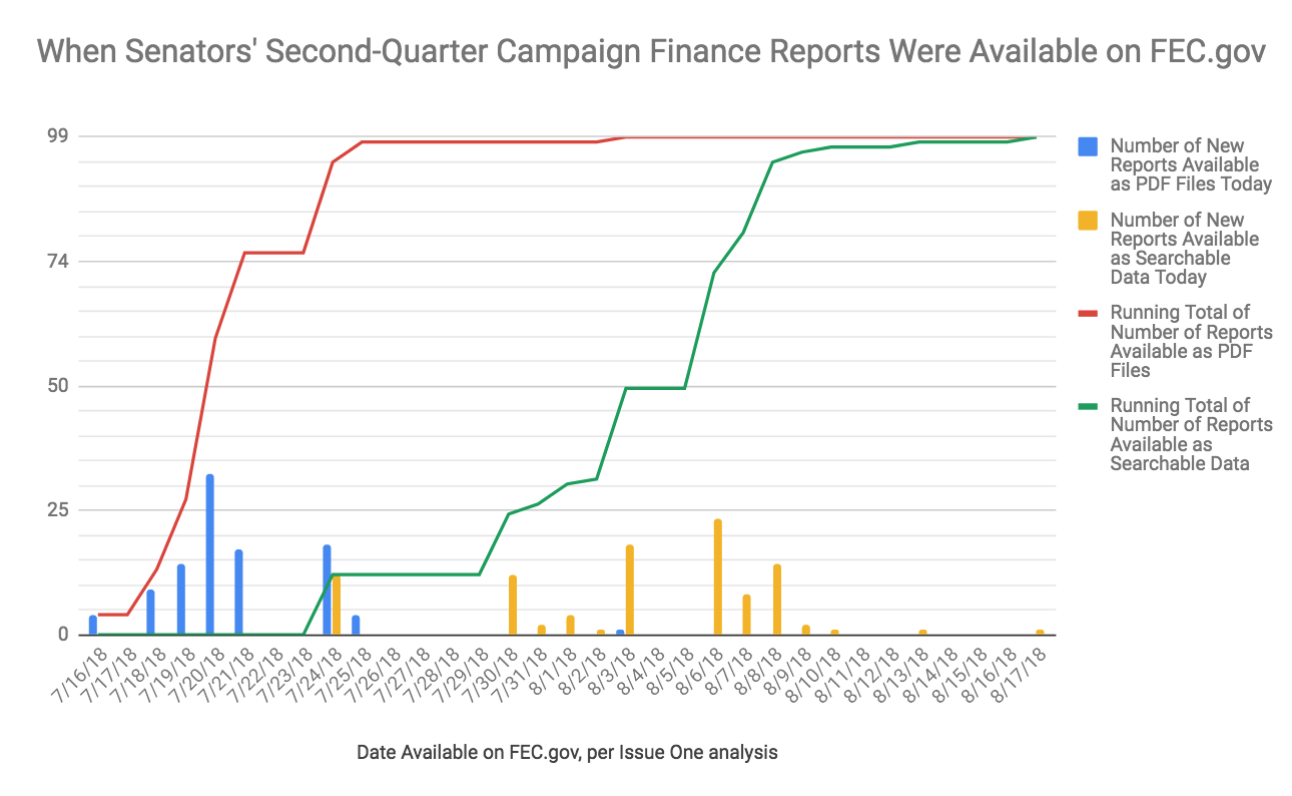All federal candidates were required to file their second-quarter campaign finance reports on Sunday, but how quickly the public can access the information in these documents depends on what kind of candidate you are.
For most federal candidates, like those running for the House or presidency, filing is a straightforward activity — and documents are available instantaneously online. For Senate candidates, however, the procedure is arcane and far from speedy.
Here’s how the Senate’s byzantine process currently works: Despite the fact that nearly all Senate candidates maintain electronic databases of their donations and expenditures, they are required, by law, to file paper copies of these disclosures. After they are received, Senate staffers scan those documents — often hundreds, if not thousands, of pages — back into an electronic format to send them to the Federal Election Commission (FEC) as pdf files. That agency, in turn, hires private contractors to perform data entry to re-digitize the information that was first stored digitally. All the while, the risk of mistakes being made is heightened as records are transferred from electronic form to paper and back again.
The Senate’s paper-based campaign finance filing system is a prime example of bureaucratic inefficiency and wasteful spending by the government. Moreover, the public is kept in the dark for days — even weeks — about who is bankrolling Senate campaigns and how funds are being spent. In 2018, this process should not be so convoluted or costly. (The FEC estimates that if Senate candidates were required to e-file their campaign finance reports, not only would this information be available online instantaneously, but taxpayers would also save nearly $900,000 a year.)
Even after these pdf files are available, it usually takes private contractors several additional weeks to key in all of the itemized transactions, which is required to give the public meaningful access to the data in a searchable, sortable and downloadable fashion.
As of 9:30 am today, the FEC’s website had pdf copies available for four sitting senators, out of the 99 that have active campaign committees. (Sen. John McCain (R-AZ), who won reelection in 2016 and is currently battling brain cancer, terminated his official campaign committee early in 2017.)
Over next few days Issue One will continue to monitor the FEC’s website and track how long it takes to process the Senate’s second-quarter campaign finance reports. We will provide regular updates until all campaign finance reports for all 99 senators with active campaign committees have been posted online for the public to see.
Every time a campaign finance filing deadline rolls around, the public gets the a chance to see where political donations are coming from and how candidates are spending the money they raise.
It is safe to say that this process is in dire need of modernizing.
Luckily, a bipartisan provision that is supported by more than half of all sitting senators and would require Senate candidates to join all other federal candidates in electronically filing their campaign finance reports was included in the Senate’s latest minibus appropriations bill. That appropriations bill was passed by the Senate in an 86-5 vote last month, and it is currently being reconciled with the House-passed version in a conference committee.
Update, July 17, 2018: As of 9:30 am ET today, the FEC’s website still only had pdf copies available for 4 sitting senators, out of the 99 that have active campaign committees.
Update, July 18, 2018: As of 10 am ET today, the FEC’s website had pdf copies available for 13 sitting senators, out of the 99 that have active campaign committees.
Update, July 19, 2018: As of 10 am ET today, the FEC’s website had pdf copies available for 28 sitting senators, out of the 99 that have active campaign committees.
Update, July 20, 2018: As of 9:30 am ET today, the FEC’s website had pdf copies available for 60 sitting senators, out of the 99 that have active campaign committees.
Update, July 23, 2018: As of 9:30am ET today, the FEC’s website had pdf copies available for 77 sitting senators, out of the 99 that have active campaign committees.
Update, July 24, 2018: As of 9:30am ET today, the FEC’s website had pdf copies available for 95 sitting senators, out of the 99 that have active campaign committees.
Update, July 25, 2018: As of 9:30am ET today, the FEC’s website had pdf copies available for 98 sitting senators, out of the 99 that have active campaign committees.
Update, July 26, 2018: As of 9:30am ET today, the FEC’s website still only had pdf copies available for 98 sitting senators, out of the 99 that have active campaign committees.
Update, July 27, 2018: As of 9:30am ET today, the FEC’s website still only had pdf copies available for 98 sitting senators, out of the 99 that have active campaign committees.
Update, July 30, 2018: As of 9:30am ET today, the FEC’s website still only had pdf copies available for 98 sitting senators, out of the 99 that have active campaign committees.
Update, August 1, 2018: As of 9:30am ET today, the FEC’s website still only had pdf copies available for 98 sitting senators, out of the 99 that have active campaign committees.
Update, August 2, 2018: As of 9:30am ET today, the FEC’s website still only had pdf copies available for 98 sitting senators, out of the 99 that have active campaign committees.
Update, August 3, 2018: As of 9:30am ET today, the FEC’s website had pdf copies available for 99 sitting senators, out of the 99 that have active campaign committees.
Update, August 17, 2018: As of 10 AM ET today, 33 days after the July 15 second-quarter filing deadline, the FEC’s website now has searchable, sortable and downloadable data available for all second-quarter campaign contributions and expenditures for all 99 senators that have active campaign committees.






